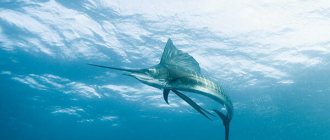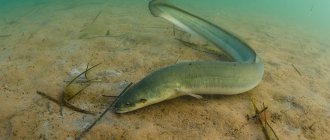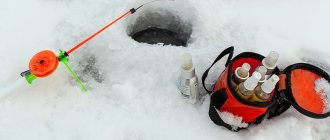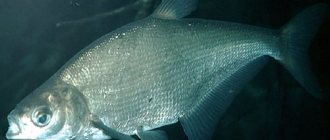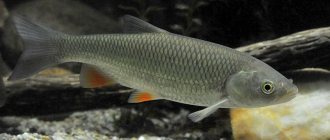Taxonomy and General Characteristics
The Black Sea shark Katran has many names. It's called:
- sand katran;
- southern katran;
- marigold;
- dogfish;
- common katran;
- spotted shark;
- shortfin shark;
- blunt-nosed shark.
All the abundance of these names refers to fish from the order Katraniformes, the family Katranidae, a genus of spiny sharks.
On average, representatives of this formidable tribe reach about a meter in length. The maximum size of a caught specimen was recorded to be just over one and a half meters.
The spiny shark has a streamlined body shape, which allows it to develop great speed. Males are smaller than females. On average, they reach sizes of 60-90 cm. Females are larger - their size ranges from 75-105 cm. Individuals weigh no more than 10 kg.
We also recommend reading:
Do-it-yourself tackle for carp Fish of the trout species: characteristics and fishing Culinary value of sea bass Tasty and healthy hominy made from corn grits
Almost all names of this fish contain the epithet “spiny”. This is due to the fact that there are sharp spines at the base of its dorsal fins. The first spine is shorter than the dorsal fin, the second is slightly longer than the other dorsal fin. This is how the sea dog protects itself from numerous enemies who want to eat it.
Its skin has small placoid scales. The general color is dark gray, sometimes with small white spots. The snout has a typically shark-like pointed shape. The eyes are relatively large, located at an equal distance from the tip of the snout and the first gill slits.
Sharks
Spiny shark - katran
The common katran is a representative of a large family of spiny sharks and the most common selachia in the seas washing the shores of Russia.
Species name
Katran common, short-finned spiny shark, dog shark, dog shark, marigold, spotted spiny shark, blunt-nosed spiny shark, etc. The Latin name of the species is Squalus acanthias (Linnaeus, 1758).
Taxonomy
- Order: Katraniformes (Squaliformes)
- Family: Dog or spiny sharks (Squalidae)
- Genus: Spiny sharks or katrans (Squalus)
- Species: Shortfin spiny shark or common dogfish (Squalus acanthias, Linnaeus, 1758).
Habitat
Katran is distributed in many seas of the World Ocean, avoiding only too warm and too cold waters. It is not found in the tropical zone, in the harsh seas of the Arctic and off the coast of Antarctica. Common in the Black, Azov, Baltic, White, Barents, Okhotsk and Japanese seas. It prefers to stay close to the shores, at depth, and only rises to the surface at night. They do not make long-distance migrations, but there are exceptions. There is a known case when a katran tagged off the coast of California was caught 7 years later near the Japanese coast.
Dimensions
The maximum length of this shark barely exceeds the two-meter mark - it is a medium-sized predator. In exceptional cases, it can reach a weight of 18-20 kg. The average size of a katran is 100-120 cm with a weight of 10-12 kg.
Appearance
The appearance of the katran is typical of most sharks - a slender spindle-shaped body, a conical head on which there are oval eyes, nostrils and a sickle-shaped mouth, normally closed. There are no eye membranes. The caudal fin is clearly heterocercal in shape with an elongated oar-shaped upper lobe. The dorsal fins are equipped with prickly spines, to which poison produced by a special gland can be supplied through a channel. A distinctive external feature of all spiny sharks is the absence of an anal fin. The color of the back of the katran is gray-steel, sometimes with a brownish-brown tint. The ventral side is ash-white. There are often small light spots on the sides, to which the katran owes one of its many names. The teeth are small, fang-shaped, the lateral ones have three tips - a high central one and a pair of tiny ones on the sides. In total, there are 100-105 teeth on the jaws of the katran.
Diet
Like all sharks, katrans are predatory carnivorous fish. The food for the shortfin spiny shark is small fish (herring, anchovy, horse mackerel, gobies, juvenile cod and other larger fish, etc.) and bottom animals (shrimp, crabs, amphipods, small octopuses, squid, etc.).
Behavioral features
Usually, Katrans prefer to stay at a depth of 50-150 meters, but they also make daily migrations, rising at night to the upper layers of water and to the surface. At night they are actively searching for food. They often form small flocks.
Structural features and interesting properties of the organism
External distinguishing features of Katrans include the absence of an anal fin and the presence of spines in the dorsal fins. The meat and fins of this shark are eaten boiled, fried, smoked and salted. Katran is one of the few sharks whose meat has almost no ammonia smell, so it does not require pre-treatment before cooking. Smoked katran is a famous delicacy. Medical preparations are made from the liver and cartilage of the katran. Medicines made from shark cartilage are known for their miraculous properties, but their effectiveness is highly questioned by experts.
Reproduction
Ovoviviparous species - incubation of the egg takes place in the mother's body. Mating of katrans in the northern hemisphere occurs in the spring, in April-May. The female bears eggs for a very long time - from one and a half to two years. The brood consists of 15-20 cubs 20-25 cm long. Young Katrans reach sexual maturity at 12-15 years of age (females a little later), with a length of at least 100 cm. The average lifespan of Katrans is 25 years.
Threat of extinction
The common katran is not a protected species of shark. It is an object of sport and recreational fishing. You can find out how to catch a katran here.
Danger to humans
Katran thorns pose a certain danger. If you handle the caught fish carelessly, you can seriously injure your hands with these spines and get a dose of poison, which causes very unpleasant sensations. In addition, mucus can introduce an infection into the wound. There is no documentary evidence of katran attacks on people. In the middle of the last century, information flashed in the Crimean media about a katran bite on the toe of one of the women relaxing on the beach. But this case has no documentary evidence.
Quite often, katrans harm fishermen by stealing their catch and tearing apart fish stuck in the nets. Fishermen even have to wait out periods of mass invasion of these sharks in order to continue fishing.
Gallery: Katran shark (25 photos)
Habitats
The spiny shark is ubiquitous on the continental shelf of the temperate climate zone.
The range is extensive. It can be described as follows:
- Western Atlantic - from the island of Greenland to the coast of Argentina;
- Eastern Atlantic - from Iceland to South Africa;
- Mediterranean Sea;
- Black Sea;
- Pacific Ocean - in the areas of New Guinea, Japan, Korea, Northern China, the Bering and Okhotsk Seas;
- South coast of Australia and New Zealand.
Depending on their habitat, these fish have a number of populations. The Black Sea katran is the only representative of sharks that lives in the European part of the Russian Federation. Those sharks that swim into the Far Eastern seas of Russia belong to a slightly different, albeit related species.
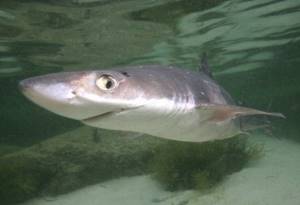
Lifestyle
These sharks, despite their excellent ability to swim quickly and even swiftly, prefer to stay near the bottom. Perhaps this habit occurs due to the fact that they live mainly on the shelf, that is, in waters with shallow depths. For example, in the Black Sea, specimens are found both in the thickness and even at the surface of the water.
These fish are capable of making large seasonal migrations. They gather in large schools. Moreover, flocks are divided by gender and size.
Habitats: coastal zones of the seas. However, there are cases when the katran swims into river estuaries. The change in water salinity does not bother him.
How dangerous is the Katran shark for humans?
Katranas do not attack people. Since ancient times and until now, not a single case of an attack by a Black Sea katran on fishermen or swimmers has been described.
From this point of view, the answer to the question of whether sharks are dangerous in the Black Sea will be negative. But do not forget that the Black Sea shark is a predator with sharp teeth and spines, so careless contact with it can lead to an unpleasant injury.
The spines of this shark are covered with mucus containing irritating substances, which, if released into the puncture wound, can lead to the development of severe swelling. You can also get scratched by the rough skin of the fish.
Divers are not recommended to try to grab a shark by the tail; in self-defense, it may bite.
Food preferences
Everyone associates the image of a shark with a stupid and aggressive predator that grabs everything. To some extent this is true. However, there are species that feed on plankton. However, this is rather an exception to the rule.
Katrans are actively included in the food chains of the seas, fortunately the shelf provides them with such an opportunity. They feed mainly on:
- mackerel;
- hake;
- gerbil;
- haddock;
- flounder;
- salmon;
- manhadenem;
- crabs;
- squid;
- octopuses;
- shrimp;
- anemones;
- jellyfish;
- algae.
In turn, this fish is a food supply for larger inhabitants of the oceans and seas. Other sharks and marine mammals, especially killer whales, feed on it. If individuals rise to the surface of the water, they become prey for birds. They are even caught by seagulls, who drag the shark ashore, throwing it onto sharp stones. The carcass is then pecked by birds of different species and sizes.
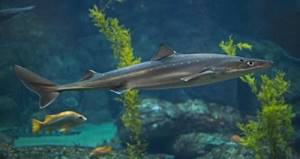
Appearance
The body of the katran is elongated and slender, with smooth, streamlined lines, reminiscent of a torpedo. This perfect form gives her the ability to move rapidly in water, even lightning fast . The color of its small scales is usually dark gray, shimmering with steel, and light, closer to the belly, but there are also individuals whose sides are dotted with small whitish spots.
The snout of the spiny shark is pointed, some even find it resembles a sturgeon, but the characteristic evil sickle-shaped “smile” and medium-sized, oval, unblinking eyes immediately reveal a merciless predator.
The teeth of the katran in its mouth are arranged in several rows; although they are small, they resemble fangs in shape and are very sharp. These dangerous tools allow her to cut and tear food into small pieces. There are at least a hundred of them, and if they are worn down, torn out or fall out, young, healthy ones quickly grow in this place.
The spines are located in front of both dorsal fins, at the very base. And if the first large fin has a small spine, then the second, smaller one has a much longer spine, it is almost the same height as the fin.
The cartilaginous skeleton significantly lightens the weight of the shark. And its size is small, for example, the Black Sea katran rarely exceeds a meter in length. Its northern cousins are usually larger. But sharks of this breed have not been recorded over 160 cm.
The speed of movement is ensured by the graceful oscillatory bends of the body, and the fins help it change and maintain the horizontal or vertical position of the body. The multi-blade tail acts as a rudder and is involved in movement.
A spiny shark can also be identified by the absence of an anal fin; this is a specific feature of the Katran shark. The photo perfectly demonstrates the appearance of the predator.
Breeding conditions
The reproduction of these fish is peculiar. They are ovoviviparous. This means that eggs (spawn) are formed, but not laid.
Their mating is internal. This happens in the spring. Eggs are formed in the dilated oviducts, located in two thin gelatinous capsules. This process of gestation of eggs inside the female's body is somewhat similar to pregnancy in birds or mammals. This pregnancy lasts from 18 to 22 months. Juveniles grown in the womb are usually born in the spring. With each litter from 1 female, about 20 fry 22-27 cm long appear.

This method of reproduction protects the young from early death at the egg stage. This increases the fertility of the species, despite the small number of individuals born per litter.
Puberty occurs depending on gender. Males become adults at the age of 11 years, reaching a length of about a meter. Females mature later - at the age of about 20 years with a height of one to one and a half meters. This fish lives for a long time, almost like a person - up to 75 years.
Nutrition and reproduction
The spiny katran shark is a predator; its main prey is demersal and pelagic fish. In addition, its diet includes mollusks and crustaceans. The katran hunts for anchovy, sprat, horse mackerel, whiting, gobies, and less often for herring, bellyfish, mullet, and burbot. Sometimes female sharks can attack dolphins.
The diet varies somewhat depending on the habitat. So, off the coast of Romania, the main diet is whiting, and near Sevastopol, crabs are added to the fish.
Females acquire the ability to reproduce at 13−17 years old with a body length of 1.1−1.3 m, males at 13−14 years old with a length of 1−1.1 m. Black Sea sharks are ovoviviparous fish, internal fertilization, no egg spawning , the female immediately gives birth to 8-15 fry 22-28 cm long, sometimes up to 33 cm.
Mating games take place in the spring, at a depth of 40 to 90 m. Then sea dogs move to depths of more than 60 m. The development of the offspring in the female’s body lasts about 18 months. This is the longest gestation period among sharks.
For spawning, fish return to a depth of 25-35 m. This happens in the second half of autumn. Both mating games and the birth of offspring take place in permanent places in the water area and can vary in time by about a month between different geographical points. After giving birth, adults go to depths of more than 60 m.
Sharks prey on fry of other fish, small mollusks and shrimp.
Use in cooking
This fish is considered a commercial fish and is in great demand in many countries. The fishery is especially developed in Japan, China, Norway, and Great Britain.
Its meat is considered nutritious. It contains 142 kcal, 20% protein, 7% fat, but no carbohydrates at all.
At the same time, fish meat contains: cobalt, sulfur, iodine, potassium, chromium, phosphorus. Of the biologically active substances, the product is rich in retinol, niacin, and tocopherol.
In addition to meat, they also eat liver and cartilage, which are considered delicacies. In addition, it is believed that they contain substances that improve human health. In particular, they improve hematopoiesis, reduce the intensity of inflammatory processes, and activate the immune system.
Katrana can be salted, dried, smoked, fried, boiled. The famous soup is prepared from the fins of this particular shark.
A fat called squalene is rendered from the liver. It is considered the lightest of all animal fats. It contains large amounts of vitamins A and D. It is used in medicine and is also used for technical purposes. Ointments are made from shark oil and used to treat joints.
Fins are used not only in cooking, but in medicine and even for technical purposes. For example, shark cartilage and skin are used to make tools that have abrasive properties. In addition, glue is made from fins and cartilage, and pepsin is produced from stomach tissue.
In addition to the delicious shark fin soup, smoked balyki, which are not inferior in taste to the famous smoked eel, are especially valued.
An intermediate product of smoked balyk is salted katran meat.
To prepare it, a large carcass is cut into pieces of the required size. They are cleaned, washed and immersed in a saline solution for two hours. After this, the pieces are washed. They can be eaten immediately or smoked.
Stewed katran is prepared as follows. Pour a small layer of vegetable oil onto the bottom of the saucepan in an amount sufficient to cover the bottom with oil.
You need to remove the skin from the fish, cut the meat into cubes or thin slices (as you like), and place it on the bottom. Place a layer of onion, cut into slices, on top, then again you need to place pieces of fish, and onion on them. If desired, you can place a layer of grated carrots on top of the fur coat. All this needs to be salted, peppered, sprinkled with spices, brought to a boil and simmered over low heat for 30 minutes without stirring. When everything is ready, you need to add chopped herbs on top. You can add apple cider vinegar or lemon juice to the onion layer.
